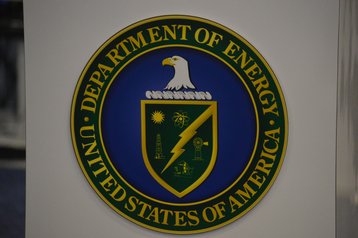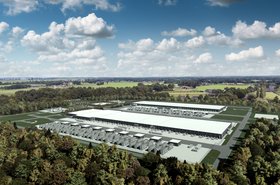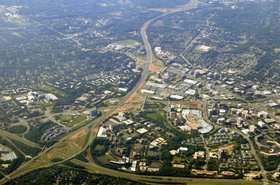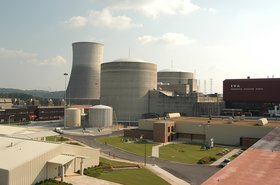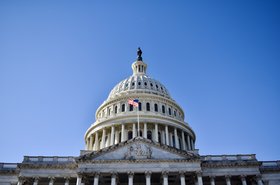The US Department of Energy's advisory board has proposed several ways to address the growing challenge of AI data center power use and its impact on the grid.
As part of its research, the board spoke to Amazon, Google, Meta, Microsoft, OpenAI, Blackrock/QTS, Digital Realty, Verrus, Nvidia, Intel, HPE, General Electric, NextEra, Portland General, CAISO, and more.
Among the numerous proposals, the board suggested building an AI data center for national labs, academia, and industry "to collaborate in development and assessment of algorithms for energy-efficient and/or energy-flexible AI training and inference."
That data center would be distinct from the DOE's supercomputing portfolio, which includes the Frontier and Aurora systems. While those are used for scientific and defense research, the testbed would instead focus on AI efficiency.
Elsewhere in the report, the board said that "the secretary should convene energy utilities, data center developers and operators, and other key stakeholders to start active dialog on how to address current electricity supply bottlenecks."
The DOE is advised to work with other government agencies and the private sector to "develop a standard taxonomy and framework for defining and orchestrating grid services for large energy users that is adaptable to local and regional circumstances and priorities."
As part of that, "the secretary should ask Congress to request routine collection of data that would allow quarterly tracking of trends in new data center commissioning and (to the extent possible) actual energy use for AI training and for AI inference, to refine models for more accurate projection of future AI energy needs and load shapes.
"DOE and the national labs should perform scenario analysis of data center power needs that address plausible scenarios of computation demands, compute efficiency, and algorithmic efficiency, including possible feedbacks where efficiency gains help drive greater computational demands."
Similarly, the report seeks to expand technical support of state energy planning departments to include analysis of infrastructure investments for data centers and other large, strategic loads, "including assessments of their potential impacts on people and communities."
It also suggests directing the DOE and the national labs to develop new planning tools for projecting future infrastructure needs to support data centers and other large loads and to expand technical support to state energy planning departments.
To help with wise grid investments, the "secretary should ask Congress to provide new authority for DOE or EIA to collect and maintain a confidential database of prospective large electric demand requests to improve efficient power system planning and address speculative and possible double counting."
A significant part of the report focuses on flexibility - shifting workloads to other data centers, or shifting to backup power sources if the grid can't handle loads.
"Hyperscalers and technology providers state that temporal and spatial computational flexibility is possible if they are given appropriate signals," the report said.
"Despite this perception of technical capability, we identified no examples of grid-aware flexible operation at data centers today other than the carbon minimizing geographic optimization that Google has employed for several years, recent efforts to respond to energy shortages in the European Union resulting from the Russian-Ukraine war, and flexibility requirements in Ireland. This lack of flexible operations in the U.S. may result from the fact that electricity providers only recently started having to say no to data center interconnection requests."
There is no standard terminology in the US for flexible operation of data centers or other assets, the report said, "which is a significant impediment to rapid the scale-up of flexibility programs even when multiple parties want to cooperate."
To address this, "the secretary should provide data center support via DOE staff and the national labs to help the centers, utilities, and state-and-local governments to explore and demonstrate innovative, flexibility solutions. Drop-in fuels provide a large opportunity for existing data centers and additional options are possible for new construction. DOE’s work on virtual power plants and microgrids could provide an important starting point."
The secretary could also support legislation to develop a specific demonstration program for innovative flexible solutions for technologies and methods deployed at the data center facility.
The companies the advisory board spoke to expressed "a broad concern about resource adequacy and reliability of today’s grid... Almost uniformly, they recommended accelerating generation and storage additions, delaying retirements, making additional investments in existing resources (e.g., uprating and relicensing of existing nuclear and hydroelectric facilities), and demonstrating new clean, firm, affordable, dispatchable technologies as soon as possible."
However, there is limited knowledge about the cost and performance of emerging technologies, so the report advises directing the DOE to "conduct a rapid assessment of cost, performance, reliability, availability, space requirements, emissions, and supply chain issues for current technologies, including renewable diesel, natural gas, renewable natural gas, fuel cells, battery storage, enhanced geothermal, long-duration energy storage, and other potentially viable technologies available to support regional data center expansion."
It should also look at the delayed retirements of coal and nuclear power plants, while a separate assessment would look into technological approaches to limit the lifetime carbon emissions of natural gas capacity additions.
At the same time, the DOE "should accelerate private investment in emerging technologies by supporting legislation that de-risks private investment in new technologies and by providing technical support to data center owners interested in making long-term financial commitments to next-of-a-kind technologies in nuclear, geothermal, long-duration energy storage, and CCS that are aligned with DOE liftoff reports."
The report added that the existing grid still has a lot of opportunity to support coming workloads, with some upgrades. To cover this cost, "it is recommended that DOE explore model tariffs that have data centers share or pay in full for required grid upgrades, to reduce the cost impact on other ratepayers."
The advisory board said that the DOE should revisit Federal Power Act 202(c) authorities to leverage data center backup capacity. "The secretary should consider the potential strategies of allowing data center and other large sources of backup generation to provide grid services to meet public needs in emergency situations and provide technical support to guide state’s efforts to enable broader use of backup generation in emergency situations."
Finally, the board suggests that the "DOE should create a prize to explore innovative technologies and methods for reduction of power, water, utilization of waste heat, and
facility level electricity supply."

